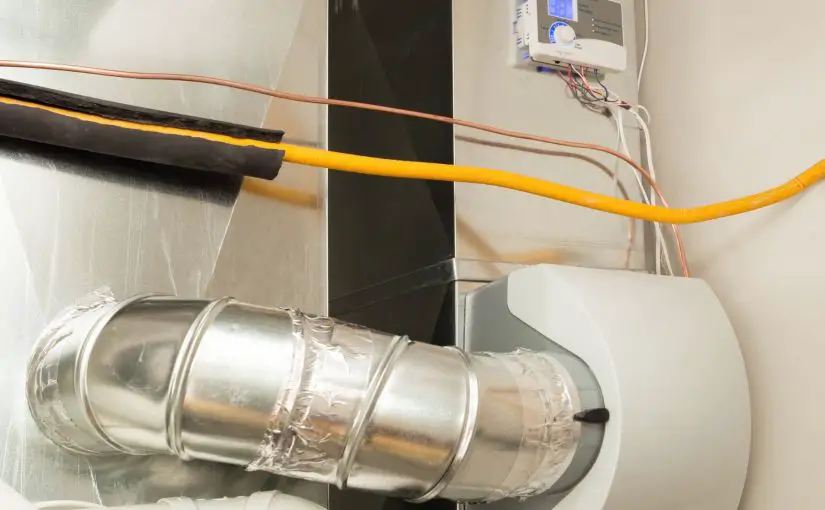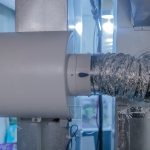Table of Contents
Introduction to Flow-Through Humidifiers
Welcome to our comprehensive guide on residential humidification systems, with a focus on flow-through humidifiers, an essential category of whole-home humidification.
Flow-through humidifiers are highly effective in evenly distributing moisture throughout an entire house, seamlessly integrating with your existing HVAC system.
In this article, we’ll delve into the world of flow-through humidifiers, covering their operation, types, installation, maintenance, troubleshooting, and more.
If you’re new to the topic of residential humidification, consider starting with our main guide. Also, explore our series of articles that delve into different humidifier technologies, such as ultrasonic, evaporative, and steam models.
Now, let’s dive into the world of flow-through humidifiers, which offer automation, efficiency, and optimal indoor air humidity when properly installed and maintained.
What is a Flow-Through Humidifier?
A flow-through humidifier is a type of humidifier that connects directly to your home’s plumbing and HVAC system, adding moisture to the air. The process involves water flowing through the humidifier, where a filter, wick, or membrane absorbs the water and exposes it to the HVAC system’s airflow.
 How Does a Flow-Through Humidifier Work?
How Does a Flow-Through Humidifier Work?
Here’s a simplified overview of how a flow-through humidifier operates:
- Water enters the humidifier from your home’s plumbing system.
- The water passes through a filter, wick, or membrane that absorbs it.
- Air from the HVAC system flows over the moistened filter/wick/membrane.
- Moisture evaporates from the filter/wick/membrane into the airflow.
- The humidified air continues through the HVAC system into your home.
Benefits of Using a Flow-Through Humidifier
Flow-through humidifiers offer various advantages:
- Evenly distribute moisture throughout your entire home.
- Require less maintenance than portable humidifiers.
- Do not take up space in your living areas.
- Can provide automatic humidistat control.
Who Can Benefit from Using a Flow-Through Humidifier?
Flow-through humidifiers are ideal for:
- Homeowners in dry climates.
- Individuals with respiratory conditions aggravated by dry air.
- Homes with forced air heating systems.
- Large homes that are challenging to humidify with portable models.
Types of Flow-Through Humidifiers
Flow-through humidifiers come in two main types:
Bypass Humidifiers
- Description: A portion of the air is diverted through a wetted pad or filter.
- Pros: Less likely to breed bacteria, no water boiling required.
- Cons: Require more maintenance than power models.
Power Humidifiers
- Description: Air is blown through a rotating disk that disperses water into the airflow.
- Pros: Require less maintenance, no stationary wick or filter to clean.
- Cons: May allow more bacterial growth, require a boiling water reservoir.
Installation and Maintenance
How to DIY Install a Flow-Through Humidifier
- Determine the optimal location on your home’s HVAC system for installation.
- Shut off the water supply and power to the HVAC system.
- Follow the manufacturer’s instructions to mount the humidifier and connect it to the water and HVAC ductwork.
- Seal all connections with tape to prevent air leaks.
- Turn the water and power back on and test for leaks.
How to Clean a Flow-Through Humidifier
- Turn off the water supply and power.
- Remove any scale buildup.
- For bypass models, replace the wick/filter per the manufacturer’s instructions.
- Remove and clean the rotating disk on power models.
- Reassemble and turn the water and power back on.
Maintenance Requirements for Flow-Through Humidifiers
- Perform annual cleaning as described above.
- Regularly replace the filter every 1-2 months.
- Check for leaks and test the humidistat calibration.
Troubleshooting Common Problems
Why Isn’t My Flow-Through Humidifier Working?
- Check if the water supply valve is turned on.
- Test if the humidistat is set high enough.
- Clean the filter or wick if it’s dirty.
- Replace any defective parts like solenoid valves.
 How Do I Fix a Leaky Flow-Through Humidifier?
How Do I Fix a Leaky Flow-Through Humidifier?
- Tighten any loose fittings.
- Replace worn-out gaskets and seals.
- Clean limescale buildup around fittings.
- Repair any cracks in the evaporation chambers.
How Do I Get Rid of White Dust from My Flow-Through Humidifier?
- Regularly clean and replace filters.
- Use distilled or demineralized water.
- Consider installing a reverse osmosis pre-filter.
Sizing Guide
Choosing the right-sized flow-through humidifier for your home is crucial to provide adequate moisture without over-humidifying. Follow these tips:
- Calculate the square footage of your living space (generally, you need 1 gallon of moisture per 100 square feet).
- Consider the number of occupants (around 10 gallons of moisture per person).
- Check the capacity of your HVAC system and size the humidifier to the air handler’s specifications.
- Select a model with an adjustable humidistat for fine-tuning moisture output.
- For very dry climates or large, open floor plans, consider larger units or multiple units.
Humidistat Settings
The humidistat controls the level of moisture that the flow-through humidifier adds to your home. Follow these guidelines:
- Start at 35% relative humidity and monitor comfort.
- Slowly increase to 45% if more humidity is needed.
- For infants and health conditions, 30-40% is recommended.
- To prevent mold, keep it under 50% maximum.
- Adjust seasonally to account for changes in climate.
- Allow 24 hours for the humidistat to stabilize at a new setting before readjusting.
Health Benefits
Proper humidity levels between 30-50% can offer numerous health and comfort benefits, such as:
- Alleviating symptoms of allergies, asthma, sinusitis, and other respiratory issues.
- Preventing dry skin, cracked lips, bloody noses, and skin irritation.
- Reducing the likelihood of cold and flu virus spread.
- Soothing irritated eyes and contact lens discomfort.
- Lowering the chances of vocal cord strain and respiratory infections.
- Preventing dryness that can damage musical instruments.
Energy Savings
Maintaining proper humidity with a flow-through humidifier can improve your HVAC system’s efficiency:
- Humidity allows the air to retain heat better, enabling a lower thermostat setting.
- Humid air feels warmer, allowing you to lower the thermostat by 2-3°F without sacrificing comfort.
- Fewer cycles of the HVAC system lead to improved moisture retention.
- Estimated annual savings on heating and cooling costs range from 5-15%.
Sizing Recommendations
Here’s a general guideline for the humidity output needed based on home size:
- 500 sq ft: 1-2 gallons per day
- 1000 sq ft: 2-4 gallons per day
- 1500 sq ft: 3-6 gallons per day
- 2000 sq ft: 4-8 gallons per day
- 250
0+ sq ft: 5-10+ gallons per day
Remember to consider climate and the number of occupants when sizing the humidifier.
Humidity Level Guidelines
Here are some recommended humidity ranges and their associated benefits:
- 30-40%: Ideal for infants and allergy/asthma sufferers.
- 35-45%: Comfortable for most homes.
- 45-50%: Maximum humidity level before risking mold growth.
Monitor the humidity with a hygrometer and adjust the humidistat seasonally.
Frequently Asked Questions
What is the ideal humidity level for a home?
Between 30-50% relative humidity is recommended. Levels lower than 30% can be unhealthy, while levels higher than 50% encourage mold growth.
How do I know if my home needs a humidifier?
Signs include static electricity shocks, dry skin, cracked wood furniture, and windows fogging up. You can use a hygrometer to test your home’s humidity levels.
What size flow-through humidifier do I need?
Consider the square footage of your home and your HVAC system’s capacity to determine the appropriate moisture output, typically 20-30 gallons per day for an average home.
Can I install a flow-through humidifier myself?
Flow-through humidifiers require integration into your HVAC system, which should be done by an HVAC professional for optimal performance and safety.
How often do flow-through humidifiers need maintenance?
In general, it’s recommended to clean and replace filters annually before the heating season. Refer to the manufacturer’s guidelines for specific model maintenance recommendations.
How much does it cost to run a flow-through humidifier?
Operating costs are low, similar to running a furnace blower. Newer computerized models can optimize moisture output for even more efficiency.
What temperature should the water be for a flow-through humidifier?
Cold tap water is suitable in most cases. Some evaporative types may require warmer water. Check your specific humidifier’s manual for guidance.
Can flow-through humidifiers over-humidify a home?
Yes, a malfunctioning unit or incorrect humidistat setting can make the air too damp. The ideal relative humidity is 30-50%.
How can I improve the air quality from my flow-through humidifier?
Use distilled water to reduce mineral dust. Replace filters as per the manufacturer’s schedule. Regularly disinfect evaporative tanks.
Are flow-through humidifiers safe for pets and children?
When installed correctly by an HVAC professional and maintained properly, flow-through humidifiers are safe and hygienic.
Conclusion
Pros and Cons of Using a Flow-Through Humidifier
Pros:
- Evenly distribute moisture throughout the entire home.
- Automatic control with a humidistat.
- Do not take up space in living areas.
Cons:
- Higher upfront cost.
- Requires professional installation.
- Additional maintenance is required.
Alternatives to Flow-Through Humidifiers
- Portable humidifiers.
- Built-in evaporative systems.
- Steam vaporizers.
- Smart WiFi-enabled humidifiers.









